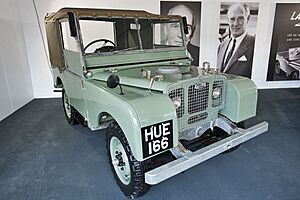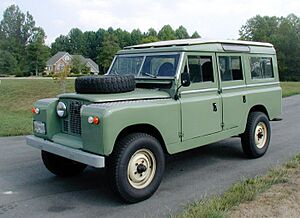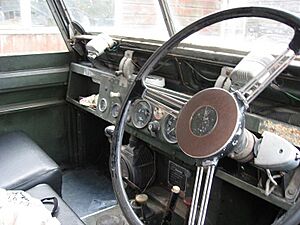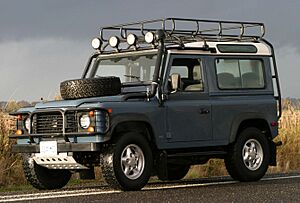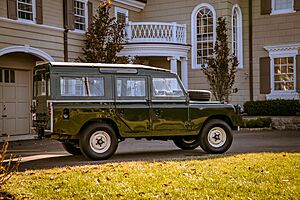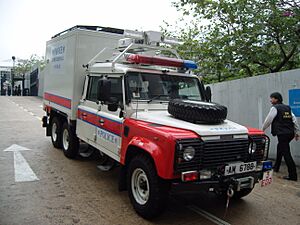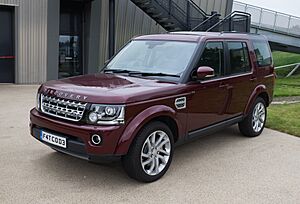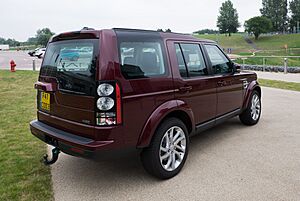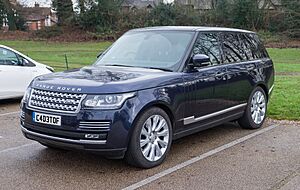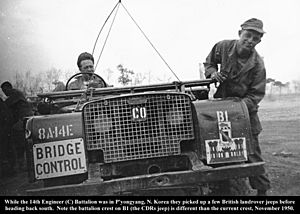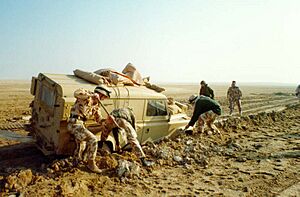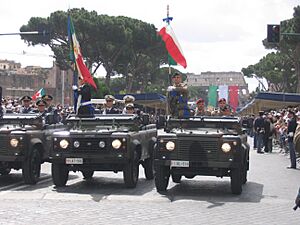Land Rover facts for kids
 |
|
 |
|
| Owner | Jaguar Land Rover |
|---|---|
| Country | United Kingdom |
| Introduced | 1948 |
| Related brands | Jaguar |
| Markets | Worldwide |
| Previous owners |
|
| Tagline | "Above & Beyond" |
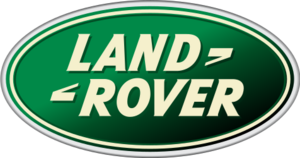 |
|
| Industry | Automotive |
|---|---|
| Fate | Merged with Jaguar Cars in 2013 |
| Predecessor | British Leyland |
| Successor | Jaguar Land Rover |
| Founded | 1978 |
| Founder | British Leyland |
| Defunct | 2012 |
| Headquarters | Solihull, West Midlands (1978–2012) |
| Parent |
|
Land Rover is a famous brand of vehicles. These cars are mostly four-wheel drive (4WD). This means power goes to all four wheels, helping them drive well off-road. Land Rover is owned by Jaguar Land Rover (JLR). JLR is a British company, and it's part of Tata Motors from India.
Land Rover vehicles are built in many countries. These include Brazil, China, India, Slovakia, and the United Kingdom. The first Land Rover was made in 1948 by the Rover Company. It was a tough 4WD vehicle for farms and rough areas. Today, Land Rover makes fancy sport utility vehicles (SUVs).
Land Rover has received special awards. King George VI gave them a Royal Warrant in 1951. This means the royal family uses their products. In 2001, they won a Queen's Award for their great work in international trade.
Over time, Land Rover became its own brand. It started with the Range Rover in 1970. Then came the Discovery in 1989 and the Freelander in 1997. The Land Rover Defender was updated in 1990. Today, Land Rover offers different models. These include two Discovery models and four Range Rover models. A new Defender model started production in 2019 for the 2020 model year.
For many years, Land Rovers used strong, box-shaped frames. This design helped them be very tough off-road. The original Defender used this type of frame until 2016. Since 2017, all Land Rovers use a unibody structure. This means the body and frame are built as one piece.
Since 2010, Land Rover has also made some two-wheel drive cars. Before this, they only made 4WD vehicles for 62 years.
Contents
The Story of Land Rover
Originally, these tough vehicles were just called 'Land Rover'. They were a model made by the Rover Company. As 'Land Rover' became a well-known brand, the older models were later called 'Series' Land Rovers. The first Range Rover came out in 1970. In 1978, Land Rover became a separate company under British Leyland.
In the 1980s, the long and short Land Rovers got official names. They were called the One Ten and the Ninety. In 1990, these models became known as the Defender. This happened after the new Discovery model was introduced in 1989.
Early Days: The Rover Era
The idea for the first Land Rover started in 1947. Maurice Wilks, who was the chief designer at the Rover Company, worked on it. He worked with his brother Spencer, who was the managing director. They worked on Maurice's farm in Newborough, Anglesey. The design might have been inspired by the Jeep. The first test car was even built on a Jeep frame.
Early Land Rovers were often light green. This was because the paint came from leftover military aircraft paint. All early models, like the Series I, had very strong ladder frames. These vehicles were built to be easy to fix, even out in the field.
After Land Rover Limited became a company in 1978, the hyphen in "Land-Rover" was slowly removed.
Land Rover as a Company
Land Rover became its own company in 1978. Before that, it was just a type of car made by the Rover Company. The original Land Rover and Range Rover models were very popular in the 1970s. This success led to Land Rover becoming a separate company. It remained part of the Rover Group until 1994.
BMW and Ford Ownership
On January 31, 1994, BMW bought the Rover Group, which included Land Rover. In 2000, BMW sold Land Rover to Ford Motor Company. Ford then made Land Rover part of its special group of luxury car brands.
BMW helped develop the Range Rover III. This was the first Range Rover to have a single body and frame structure. It also had independent suspension. Ford launched this model in late 2001.
Ford continued to change Land Rover vehicles. In 2004, they introduced a new Discovery model. This model had an "Integrated Body Frame." This meant only the Defender still used the traditional strong ladder frame.
In 2007, Ford announced it would sell Land Rover and Jaguar Cars. Many companies were interested. On March 26, 2008, Ford agreed to sell them to Tata Motors from India.
Tata Motors Era
On June 2, 2008, Tata Motors completed the purchase of Land Rover and Jaguar. They created a new company called Jaguar Land Rover Limited. This new company became the owner of both brands. The deal also included rights to other British car brands like Daimler and Rover.
On January 1, 2013, Jaguar Land Rover changed its structure. The two separate companies, Jaguar Cars Limited and Land Rover, merged. They became one company, Jaguar Land Rover Limited. This company is now in charge of designing, making, and selling both Jaguar and Land Rover vehicles.
Land Rover Milestones
- 1947: Maurice Wilks creates the first prototype using Jeep parts.
- 1948: The first Land Rover is shown to the public on April 30 at the Amsterdam Motor Show.
- 1958: Series II is launched.
- 1961: Series IIA production begins.
- 1970: The first Range Rover is introduced.
- 1971: Series III is launched.
- 1978: Land Rover Limited is formed as a separate company.
- 1980: Land Rover production moves only to Solihull.
- 1983: The Land Rover 90 and 110 are introduced.
- 1987: Range Rover is sold in the US market.
- 1989: The Discovery is introduced.
- 1990: The 90 and 110 models are renamed Defender.
- 1994: BMW buys Rover Group, including Land Rover. The second-generation Range Rover is introduced.
- 1997: The Freelander is introduced.
- 2000: BMW sells Land Rover to Ford.
- 2002: The third-generation Range Rover is introduced.
- 2004: The second-generation Discovery (also called LR3) is launched.
- 2005: The Range Rover Sport is introduced.
- 2008: Ford sells Land Rover and Jaguar to Tata Motors.
- 2010: The Discovery 4 / LR4 is introduced.
- 2011: The Range Rover Evoque is introduced.
- 2012: The fourth-generation Range Rover is shown.
- 2013: Land Rover and Jaguar Cars merge into one company, Jaguar Land Rover Limited.
- 2014: The New Discovery Range is shown.
- 2017: The Range Rover Velar is shown in London.
- 2018: Land Rover announces "Cortex" project for self-driving off-road robots.
- 2019: Land Rover announces a remote control system for the new Defender.
- 2020: The new Land Rover Defender (L663) is released.
Where Land Rovers Are Made
Jaguar Land Rover builds Land Rover cars in factories in five countries.
- In the United Kingdom, the Range Rover, Range Rover Sport, and Range Rover Velar are built at the Solihull plant. The Discovery Sport and Evoque are built at the Halewood plant.
- In October 2018, JLR opened a new factory in Nitra, Slovakia. This plant builds the Discovery and the 2020 Defender.
- In Brazil, the company builds the Discovery Sport and Evoque at its plant in Itatiaia. This factory opened in June 2016.
- JLR has been building cars in Pune, India, since 2011. They currently build the Discovery Sport and Evoque there.
- In China, Discovery Sports and Evoques are also built. This is done through a partnership with Chery at Changshu.
Historically, most Land Rovers were made at the Solihull plant. Later, the Freelander production moved to the Halewood plant. Some Defender models were also put together in other countries. These included Spain, Iran, Brazil, and Turkey.
How Many Land Rovers Are Sold
Land Rover sales around the world grew a lot from 2008 to 2016. Sales almost tripled in that time. Europe is the biggest market for Land Rover. The United Kingdom and the United States also buy many Land Rovers. Since 2012, China has become Land Rover's biggest single country market.
The Discovery Sport is the most popular Land Rover model. In 2018, over 95,000 units were sold globally. The Range Rover Sport is also very popular. The Discovery Sport took over from the Freelander model. The Freelander was Europe's best-selling SUV for five years after it came out in 1997.
Land Rover Models
Past Models
- Series I, II, IIA and III
- Freelander (also known as LR2 in some places)
Current Models
- Defender
- Discovery
- Discovery Sport
- Range Rover
- Range Rover Sport
- Range Rover Velar
- Range Rover Evoque
Concept Cars
Concept cars are special vehicles built to show new ideas. They often have futuristic designs or new technologies.
- Range Stormer: This was Land Rover's first concept car, shown in 2004. It later became the Range Rover Sport.
- Land Rover LRX: This concept was shown in 2008. It was designed to be a hybrid car. The production version, the Range Rover Evoque, launched in 2011. It was the first Range Rover with front-wheel drive.
- Land Rover DC100: This concept was shown in 2011. It was designed to be a possible replacement for the Land Rover Defender.
- Land Rover Discovery Vision Concept: This concept was shown in 2014. It was designed to be a replacement for the Land Rover Discovery. It had cool features like a "Transparent Bonnet" and special laser lights.
Military Land Rovers
Land Rover has made many special vehicles for armies around the world.
- Land Rover 101 Forward Control: A military truck from the 1970s.
- Land Rover 1/2 ton Lightweight: A light military vehicle that could be carried by helicopters.
- Land Rover Wolf: A stronger military Defender.
- Snatch Land Rover: A Land Rover with an armored body used by the UK Armed Forces.
- Land Rover Perentie: Models made for the Australian Army.
Military Use Around the World
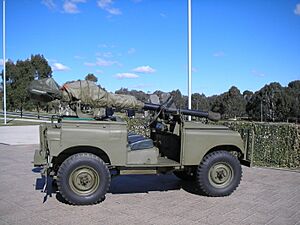

Many Land Rover models have been used by armies. The British Army and Australian Army use them a lot. These military versions have special features. They might have heavy-duty suspension, stronger brakes, and mounts for weapons.
Two models were designed just for military use. These are the 101 Forward Control and the Lightweight. The Lightweight was made to be carried under a helicopter. The Royal Air Force Mountain Rescue Service also uses Land Rovers. They help people in the mountains.
The "Pink Panther" Land Rovers
A famous military version is the "Pink Panther." About 100 Series IIA models were changed for reconnaissance (scouting) by British special forces. For desert use, they were often painted pink, which gave them their nickname. These vehicles had special gear like a sun compass, machine guns, and bigger fuel tanks.
The Australian Army also made special Land Rovers. They created the Long Range Patrol Vehicle and an anti-tank "gunbuggy" with a powerful rifle.
The 75th Ranger Regiment of the United States Army also used special Land Rovers. They were called the Ranger Special Operations Vehicle.
Armored Land Rovers
Some Land Rovers have been armored to protect people inside. The Shorts Shorland was one of the first. It was built in 1965 for the police in Northern Ireland. The British Army also uses armored Land Rovers. One well-known model is the Snatch.
A very unusual military Land Rover was the Centaur half-track. It was based on a Series III with a V8 engine. It had tracks instead of rear wheels, like a small tank.
Today, the British Army uses the Snatch 2. It has a stronger frame and suspension. They also use the Land Rover WMIK. This vehicle has weapons mounted on it, like a heavy machine gun.
Land Rover Engines
Over the years, Land Rover vehicles have used many different engines.
- Early models used petrol (gasoline) engines from Rover cars.
- Later, they used four-cylinder diesel and petrol engines. These engines evolved into the 300 TDi turbodiesel.
- The Buick-sourced all-aluminum Rover V8 engine was also used.
- In 1980, Land Rover improved its four-cylinder engines.
- The Range Rover used a V8 engine from the start in 1970.
- Newer engines like the 200TDi and 300TDi turbodiesels were used in the Defender and Discovery from 1990.
- The TD5 was a new five-cylinder turbodiesel engine for the second-generation Discovery.
- The first Freelander models used various Rover K-series engines.
- Since 2015, Land Rover has started using the new Ingenium engine family.
As of August 2012, most Land Rovers used Ford engines. Tata Motors had the right to buy engines from Ford until 2019.
Electric Land Rovers
Land Rover is also working on electric and hybrid vehicles.
- They developed "e-terrain technology" with an Electric Rear Axle Drive (ERAD). This allows the car to move without starting the engine. It also gives extra power off-road.
- In 2008, Land Rover showed a hybrid system in two Freelander 2 prototypes. This system could be used in many Land Rover models.
- The LRX hybrid concept was shown in 2008. It was designed to run on electric power at low speeds.
- In February 2013, Land Rover showed an All-Terrain Electric Defender. This vehicle produces zero emissions. It can travel 80 kilometers or last up to eight hours off-road before needing a recharge.
Land Rover Abilities

Land Rovers are known for being very capable.
- Power Take-Off (PTO): From 1948, Land Rovers could have a PTO. This allowed them to power farm machinery and other tools while the vehicle was stopped.
- Body Styles: Land Rovers (especially the Series/Defender models) come in many styles. These range from simple pick-up trucks to twelve-seat wagons.
- Special Conversions: Land Rover and other companies have made special versions. These include fire engines, ambulances, snowploughs, and even six-wheel-drive versions. Some have even been made into amphibious vehicles or fitted with tracks instead of wheels.
Driver Training
Land Rover Experience started in 1990. It's a network of centers around the world. These centers help customers learn how to use their vehicles' abilities. They teach off-road driving, how to use a winch, and how to handle trailers. They also offer fun "Adventure Days."
Safety of Land Rovers
A study in 2006 looked at road accident statistics in the UK. It showed that the Land Rover Defender was one of the safest cars on British roads. This was based on the chance of someone dying in a two-car accident. Defender drivers had a very low chance of being seriously hurt. Other 4WD vehicles also scored high. This is often because larger, heavier vehicles offer more protection to their own passengers.
Land Rover Clubs
Many Land Rover clubs exist around the world. These clubs bring together people who own Land Rovers.
- Single Marque Clubs: These clubs are for owners of a specific model, like the Land Rover Series One Club.
- Special Vehicle Clubs: These clubs are for owners of special Land Rovers. Examples include vehicles from the Camel Trophy or G4 Challenge.
- Regional Clubs: In the UK, these clubs offer social events and off-road driving. Some clubs also hold competitions.
Many clubs are part of the Association of Land Rover Clubs (ALRC). This group sets rules for competitions and events. Land Rover owners also created online clubs very early on.
Since 2005, Land Rover has shown more interest in these clubs. They even allow some clubs to use the Land Rover logo.
Other Land Rover Products
Land Rover has also put its name on other products.
Bicycles
In 1995, Land Rover allowed a company to make bicycles with its logo. The first was the Land Rover APB, a folding bicycle. Later, they released a range of 25 bicycle models in 2004. These bikes were grouped into "Defender," "Discovery," and "Freelander" ranges. Each range was designed for different types of riding.
Pushchairs
Land Rover also gave a company a license to make Land Rover ATP pushchairs (strollers). These pushchairs were designed to be tough and simple. They could be folded flat and had strong parts. They were made to travel on all types of ground. Production of these pushchairs stopped in 2002.
See also
 In Spanish: Land Rover para niños
In Spanish: Land Rover para niños


